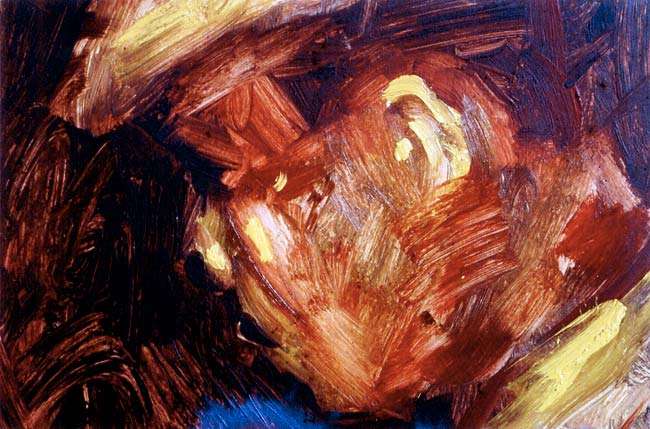Montez Magno
On the present painting by Plínio Palhano
At once what one realizes in the painting by Plínio Palhano is the nervous brushstrokes, uneasy, impulsive his technical performance cemented on a quick gestural expression, his palette conditioned to the dark tones, to the reddish sepia, which does not become monochromatic because of the fast blues and the insinuating greens, at the same time that explosive yellows give it a passional touch of cry or amazement, all of this indicating that this painter is an Expressionist: a painter who let his emotions and feelings come up almost in an unruled expression of violence. I said almost, because if it were not, Plínio would turn out a painting purely gestural and abstractionist, informal and anarchical.
I have asserted that his brushstroke is nervous, uneasy, etc., and from that point I may establish relations between his way of painting and that of other present Pernambucan painters like José Cláudio, Ana Ivo and Piedade, all of them belonging to the same family of gestural Expressionist painters, despite the difference in their subject-matters and the greater or lesser technical/factual knowledge.
Representation and expression has always been the bedrock of the Pernambucan painting, for we are a resistance zone, as Marta Traba, Argentinean art critic, would say, once the foreign influences, the visual information that reach us, all of them are necessarily filtered, they pass through a sieve of which finer grains are some references and revivals that are adapted. The Pernambucan art is, for the most part, conservative, the exceptions are rare and not always cogent.
In the case of Plínio Palhano, his major wellspring comes from the trio of the most expressive artists: it is in Soutine, Daumier and Van Gogh that Palhano finds his groundwork and kinship for elective affinity recognized by the painter himself.
The references I have made to the influences, kinships and affinities between Plínio´s work and that of foreign artists are not at all disparaging statements about him, much to the contrary, all his artistic mentors are of high rank, a considerable credential to his post of painter. By the way, Octavio Paz, in his foreword to the book "Pathways of Oku" by Matsuo Basho, says that "the man is the men and the culture is the cultures", meaning that all that it is human belongs to every men and every cultures. So that to receive influences or have affinity with this or that artist ought to be accepted with ease, not with prejudices and provincialisms.
The theme of this exposition is the country man, the sugar-cane plantation worker, the sugar-cane cutter, common people in their daily routine repeating the same gestures of their hard work just like us townees who, in our own way or differently, also repeat everyday the same gestures of yesterday.
The titles themselves and the themes (Carrying Sugar-cane, Sharpening Sickle, Cutting down Sugar-cane, Packing the Animals, Water for Work, etc.) show that Plínio is an artist worried (at least plastically) about the needy, hence his painting is overflowing with a dramatic feeling.
From the merely technical point of view, the pictures Worker, Strength and Carrying Sugar-cane II, are, in my view, the most well-accomplished ones, with a steadier brushstroke and a thicker and more adequate use of the paint.
It also seems that larger canvases could provide the painter with a broader space for his gestural expression. There is also a tendency for informal abstraction when the figurative shapes are just hinted or, some times, almost disguised, therefore not always having an accomplishment of the figure.
One feels that, on the whole, the strength of the painting by Plínio Palhano lies in the dramatization of the expression, in the speed of the gesture, leading the onlooker through his sensations, feelings and sensorial impulses, inasmuch as it is not a cerebral painting, even though it takes us to give it some thought.
Olinda, August 17, 1982.
Back to LANDSCAPE OF OUR LIFE




